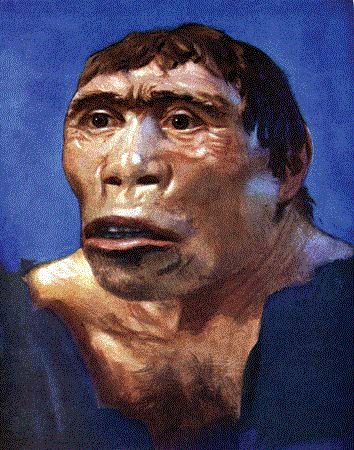The Homo Erectus Java Man
JAVA MAN
"Pithecanthropus erectus"" was the name first given to the Homo erectus specimen, also known as Java Man, by its discoverer Eugene Dubois. The word "pithecanthropos" was derived from Greek roots and means ape man. See also Peking Man
It is interesting to note that the find was not a complete specimen, as many are led to beleive, but consisted merely of a skullcap, a femur, and three teeth. A 342 page report written shortlyafter the finding has thrown much doubt upon the validity of this particular specimen. Despite this, the "Java man" is still found in many textbooks today.
A second "Java Man" was later discovered in the village of Sangiran, Central Java, 18km to the north of Solo. His remains, a skullcap of similar size to that found by Dubois,was discovered by Berlin-born paleontologist Dr GHR von Koenigswald in 1936, as a direct result of the excavations by Dubois in 1891.
Until older human remains were later discovered in the Great Rift Valley in Kenya, Dubois' and Koenigswald's discoveries were the oldest hominid remains ever found, and the first to support Charles Darwin's and Alfred Russell Wallace's theory of evolution.
Many scientists of the day even suggested that Dubois' Java Man might have been the so-called "missing link", yet due to 19th Century scepticism, this theory was never credited to Dubois.
The "missing link" is the creature that is supposed to provide the evolutionary connection between the anthropoid apes and modern man.
Other Skulls Found
- For more than 29 years, Dubois did not declareed to the scientific community that he had also found two human skulls in the same general location and level in a gravel place.
- These were the so-called Wadjak skulls. Many have said that this was because he knew it would detract from the willingness with which his 'Java man' find would be accepted as man's ancestor.
- However, from his own writings and other sources, Dubois in fact had a doubtful nature, and even locked his 'Java man' find a way for years, even though many were convinced it was the 'missing link'.
- 'Java man' has been renamed so as to now belong to the class of Homo erectus.
- However, readers should be aware that though there are really realistic specimens, which has been named Homo erectus there is no motive to believe that 'Java man' essentially even belonged to this class, nor had any objective survival at all.
Arguments about Java Man
Many creationists have claimed that Java Man, discovered by Eugene Dubois in 1893, was "bad science". Gish (1985) says that Dubois found two human skulls at nearby Wadjak at about the same level and had kept them top secret, that Dubois later determined Java Man was a giant gibbon, and that the bones do not comefrom the same human beings.
Most people would find Gish's meaning of "nearby" amazing, the Wadjak skulls were found 65 miles (104 km) of mountainous countryside away from Java Man. likewise for "at around the same level": the Wadjak skulls were found in cave deposits in the mountains, while Java Man was found in river deposits in a flood plain (Fezer 1993). Nor is it true, as is often claimed, that Dubois kept the existence of the Wadjak skulls secret because knowledge of them would have disgraceed Java Man.
Dubois briefly Explained the Wadjak skulls in three separate publications in 1890 and 1892. Despite being corrected on this in a debate in 1982 and in print (Brace 1986), Gish has continued to make this claim, even stating, despite not having apparently read Dubois' reports, that they did not mention the Wadjak skulls (Fezer 1993).
- Lubenow does recognized the existence of Dubois' papers, but argues that since they were technical reports not intended for the public or the scientific community
- Dubois was still guilty of hiding the existence of the Wadjak skulls.
- This is also incorrect; the journals in which Dubois published, although unclear, were distributed in Europe and America, and are part of the scientific literature.
- Based on his own theories about how brains had changed and wishful thinking.
- Dubois did claim that Java Man was "a gigantic genus allied to the gibbons", but this was not, as creationists mean, a withdrawal of his earlier claims that it was an intermediate between apes and humans.
- Dubois also pointed out that it was bipedal and that its brain size was "very much too large for an anthropoid ape"
- and he never stopped believing that he had found an ancestor of modern man (Theunissen 1989; Gould 1993; Lubenow 1992).
- Creationists are right about one thing. Most modern scientists agree that the femur is more modern than the skullcap, belonging to a modern human.
- Some of the teeth found nearby are now thought to be from an orang-utan, rather than Homo erectus.
- It is instructive to listen to Gish (1993) expounding on the apelike qualities of the skullcap.
Was Java Man a Gibbon ?
"Pithecanthropus [Java Man] was not a man, but a gigantic genus allied to the gibbons, however superior to the gibbons on account of its remarkably large brain volume and distinguished at the same time by its sense of assuming an erect attitude and gait .It had the twice cephalization [ratio of brain size to body size] of the anthropoid apes in general and half that of man."
"It was the amazing volume of the brain - which is very much too large for an anthropoid ape, and which is small compared with the average, though not smaller than the smallest human brain that led to the now approximately general view that the "Ape Man" of Trinil, Java was really a ancient Man. Morphologically, however, the calvaria [skullcap] closely resembles that of anthropoid apes, especially the gibbon."













0 comments:
Post a Comment